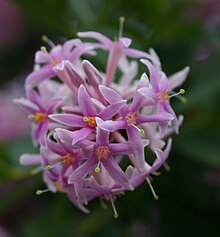Dais cotinifolia
| Dais cotinifolia | |
|---|---|

| |
| Scientific classification | |
| Kingdom: | Plantae |
| Clade: | Tracheophytes |
| Clade: | Angiosperms |
| Clade: | Eudicots |
| Clade: | Rosids |
| Order: | Malvales |
| Family: | Thymelaeaceae |
| Genus: | Dais |
| Species: | D. cotinifolia
|
| Binomial name | |
| Dais cotinifolia | |
| Synonyms | |
| |
Dais cotinifolia, known as the pompom tree, is a small Southern African tree belonging to the Thymelaeaceae family. It occurs along the east coast northwards from the Eastern Cape, inland along the Drakensberg escarpment through KwaZulu-Natal and the Transvaal, with an isolated population in the Eastern Highlands of Zimbabwe. It flowers profusely during the summer months and produces a multitude of pink, sweet-scented, globular flowerheads about 10 cm across. Depending on the circumstances it can reach a height of up to 12m, although it rarely exceeds 6m in cultivation.
Description[edit]
Deciduous, bushy, with neat shape, its height and span only reaches 2-3m (in the UK).[1] It can reach up to 4 metres in Australia.[2] It has small ovate-oblong shaped and lustrous leaves up to 5mm long.[1] It is evergreen in mild climates and deciduous in cool climates.[2] In spring,[2] or in the summer,[1] it bears scented star-shaped rose-lilac,[1] or pink coloured flowers,[2] in flattened clusters that are 8 cm wide across.[1]The bark is tough and fibrous and the branchlets are difficilt to break.[3]
Uses[edit]
Used as an ornamental in gardens,[1] can be grown as a small tree or multi-stemmed shrub.[2] It prefers siting in the garden in full sun and in fertile and well drained soils.[1][2]
Although, it's bark yields fibres that are strong enough to be used as thread.[1]
See also[edit]
References[edit]
- ^ a b c d e f g h Christopher Brickell RHS Encyclopedia Of Plants and Flowers (2019), p. 561, at Google Books
- ^ a b c d e f "Plant Profile - Pom Pom Tree". Australian Broadcasting Corporation. 9 April 2016. Retrieved 23 August 2021.
- ^ Van Wyk, Braam; Van Wyk, Piet (1997). Field guide to trees of Southern Africa. Struil. ISBN 1 86825 922 6.
- "Dais cotinifolia". PlantZAfrica.com. Retrieved 2010-01-28.
